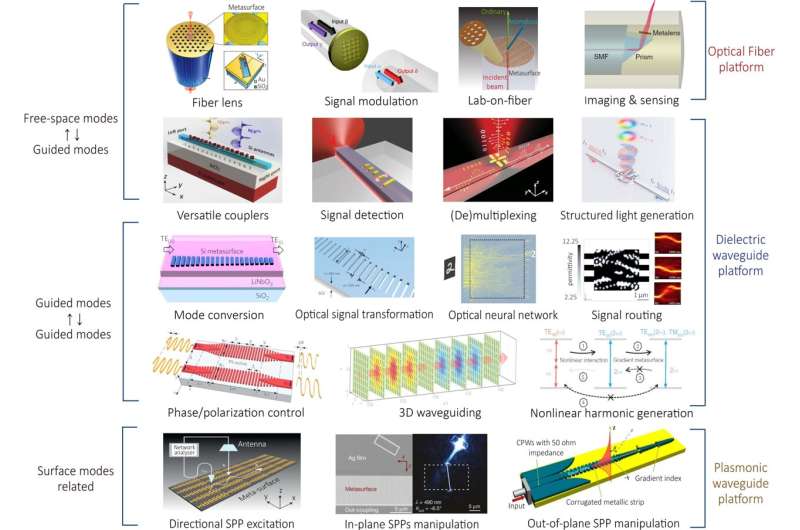Subwavelength photonic architectures can be integrated with diverse waveguide platforms to develop versatile meta-devices for massive applications. Credit: Yuan Meng, Yizhen Chen, Longhui Lu, Yimin Ding, Andrea Cusano, Jonathan A. Fan, Qiaomu Hu, Kaiyuan Wang, Zhenwei Xie, Zhoutian Liu, Yuanmu Yang, Qiang Liu, Mali Gong, Qirong Xiao, Shulin Sun, Minming Zhang, Xiaocong Yuan, and Xingjie Ni
Comprised of judiciously engineered microscopic photonic structures with subwavelength features, the concepts of metasurface and metamaterials have proven fruitful results in the realm of meta-optics. Previous research attentions are mainly devoted to applying meta-structures to tailor light in free space and develop relevant devices and applications. However, recent research is revealing the prominent potential of leveraging subwavelength meta-structured waveguides to enable exotic waveguiding phenomena and design novel waveguide-based devices.
For instance, photonic integrated circuits are emerging as a promising candidate to revolutionize conventional integrated electronic circuits for their exceptional advantages such as broad bandwidth, high operation speed, and low power consumption. Nevertheless, as the most fundamental building block of integrated photonics, conventional optical waveguides still encounter challenges in terms of bulk footprint, compromised light-matter interaction efficiency, and restrained available functionalities. Fortunately, the concept of meta-waveguides can be adopted here to open a new avenue towards powerful manipulation of guided light in subwavelength scale, infusing new degrees of freedom into waveguide landscapes to dramatically boost device performance and enable novel functionalities.
In a new paper published on the journal of Light: Science & Applications, a team of scientists from China, United States and Italy has presented a comprehensive review article offering a panorama on the optics of meta-waveguides. The latest advances on various subwavelength meta-structured waveguides are systematically catalogued, encompassing a broad class of photonic devices and systems that ally metamaterials and metasurfaces with diverse optical waveguides (dielectric/plasmonic/optical fibers). Brief physical fundamentals with explicit design methods (including both forward and inverse design tutorials) and representative applications for meta-waveguides are comprehensively summarized. The authors highlight how incorporating the concepts of meta-optics with waveguide technologies can propel photonic integrated circuits into new heights, by providing versatile efficient coupling interfaces, novel on-chip optical signal processing paradigms and diverse platforms for sensing, imaging and artificial intelligence.
The paper introduces the zoology of meta-waveguide family. A plethora of applications are prototyped on this flexible playground, including, for instance, metasurface-patterned dielectric waveguides, forward designed metamaterial waveguides, metasurface- or metamaterial-hybrid optical fibers, meta-structures- assisted plasmonic waveguides, and inverse designed metamaterial waveguides, to name a few.
The researched also illustrates that meta-waveguides can be classified via either design methods or underpinning waveguide platforms.
"On the one hand, meta-waveguides can be conceived by physical intuition-based approaches (namely forward design henceforth) by leveraging the toolbox of metasurfaces and metamaterials with waveguide optics," the researchers note.
"On the other hand, we can also use inverse design, which relies on computer optimizations ... to develop free-formed analog (curvilinear boundaries) or digital (with relatively regular boundaries) metamaterial waveguides," they add.
Photonic structures with subwavelength devised details are canonical to meta-waveguides. Taking two-dimensional periodic silicon segments as an instance, the meta-waveguides should be modeled as a designer effective medium, which is different from the photonic bandgap theory found in photonic crystals or scalar diffraction theory used in non-subwavelength gratings.
"Despite the concept of meta-waveguides is still in its infancy, exciting progress [is emerging] with bright perspectives and profound potential applications. As conceptually illustrated [...] the advancement of meta-waveguides can not only extend meta-optics to the realm of guided electromagnetic waves and waveguide technology, but also promise to reshape the landscapes of photonic integrated circuits and massive emergent applications," the scientists envisaged.
Meta-waveguides may further venture photonic integrated circuits and many relevant applications in biomedical sensing, imaging, and detection into new territories. Massive novel emerging device functions still await exploration in this vibrant field.
More information: Yuan Meng et al, Optical meta-waveguides for integrated photonics and beyond, Light: Science & Applications (2021). DOI: 10.1038/s41377-021-00655-x
Journal information: Light: Science & Applications
Provided by Chinese Academy of Sciences
























